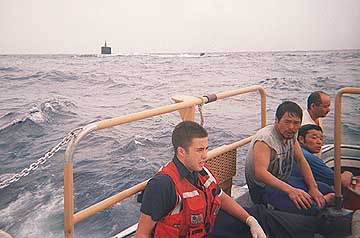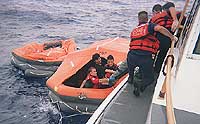 |
| A Coast Guardsman and rescued crew and passengers from the Ehime Maru rest on the deck of a Coast Guard ship. The submarine USS Greeneville, which struck and sank the fishing boat, is in the background.
|
 9 missing after sub hits Japanese ship 9 missing after sub hits Japanese ship
 Japanese school anxiously awaits news of students on boat Japanese school anxiously awaits news of students on boat
 Accident while surfacing a real fear Accident while surfacing a real fear
 Investigation into collision promised Investigation into collision promised
 Graphic of how the collision happened Graphic of how the collision happened
 See video of the Coast Guard rescue effort in large (6.8 Mb), small (1.1 Mb) or streaming format. Video courtesy KHON-TV. See video of the Coast Guard rescue effort in large (6.8 Mb), small (1.1 Mb) or streaming format. Video courtesy KHON-TV.
By Jennifer Hiller
Advertiser Staff Writer
In the frantic final moments of the Ehime Maru, crew members heard a loud thump and felt a shudder move through the hull. The power was lost, the lights went out and water poured into the ship, nine miles off Diamond Head.
Rushing water swept one person from the deck. Soaked in diesel fuel, they struggled off the vessel and clung to six life rafts set adrift in 6- to 8-foot seas.
Within minutes, their ship was gone.
"After the first boom the ship sank in 10 minutes," the Ehime Maru’s captain told Coast Guard Petty Officer and translator Mike Carr. "It sank straight down. It just settled straight down."
Nine people — three crew members, two teachers and four cadets — remained unaccounted for in the waters off O‘ahu early today. The Pearl Harbor-based submarine struck and sank the 174-foot Japanese high school training vessel with 35 people aboard yesterday afternoon.
The 26 survivors arrived at the Coast Guard Honolulu Station at Sand Island soaking wet, shivering, shoeless and wrapped in gray blankets. Several were seasick, and some were treated for hypothermia.
 |
| Coast Guard rescue personnel help seamen out of their life rafts.
U.S. Coast Guard |
Twelve of the survivors, mostly with minor injuries, were taken to local hospitals. The 14 who were not hurt, including the captain, were taken to the Coast Guard’s gym at Sand Island, where they took showers to wash away the diesel fuel and were given food and a change of clothes. Coast Guard officials questioned the group to try to glean information to help with rescue attempts.
Last night, about 20 crew members were taken to the Ala Moana Hotel, where they ate a light dinner in one of the hotel restaurants and spent the night. Dressed in Navy-issued blue jumpsuits, the men ate little and spoke quietly among themselves.
Hisao Onishi, 58, the captain of the Ehime Maru, appeared tired, with swollen eyes. Speaking softly through an interpreter, Onishi declined to talk about the accident, saying he was still in shock.
"I’m thinking of people who are still missing and dead," he said.
Hiroyuki Hosokawa, one of eight survivors who were taken to the Kaiser Moanalua Medical Center, said he was below deck on the Ehime Maru when he felt two shocks. He said he walked out into a corridor where he could look down onto the bottom level, and he could already see that it was filled with diesel fuel.
Those aboard the ship told the Coast Guard they lost electricity within 15 seconds of the collision. The life rafts automatically inflated.
The captain and two mates were on the bridge at the time of the collision, but most of those aboard were in the mess hall. Several of the missing were below deck in the engine room, the captain said.
Tommy Kron, executive petty officer for the Coast Guard, was on the 41-foot utility boat that was one of the first to arrive at the scene.
"The only thing we saw was a submarine, some life rafts and a little bit of debris," he said. "It seemed like they were in shock. They were fatigued by the time we got there. Some were seasick."
The water was choppy with 6- to 8-foot swells, he said. "They were pretty quiet," he said of the survivors. "I think a lot of them were too seasick to move."
Kron’s utility boat arrived on the scene about 2:45 p.m., and by 3 p.m. they started bringing survivors aboard. There was a sheen of fuel on the water stretching about 200 yards, and debris from the sunken ship began to surface and drift.
"Some had swallowed diesel, making them sick," Kron said.
The submarine was nearby but couldn’t rescue anyone, Kron said. The only damage he could see was a paint scrape on the rudder, he said. But the training ship was gone.
"None of them had their life jackets on," he said of the survivors. "Might not have had enough time."
Gabe Sage, a Coast Guard aviation survival technician, was flown by helicopter and jumped into the water to assist in the rescue. He said the 26 survivors were in six rafts, three of them tied together. He could not see anyone in the water.
"Everyone was complaining about a lot of diesel fuel fumes in their eyes," he said.
The eight survivors taken to Kaiser Moanalua went through a decontamination process to have their eyes and ears flushed. All eight will also have chest X-rays as a precaution to make sure none of them swallowed diesel or sea water or have any in their lungs, said spokeswoman Jan Kagehiro.
Those left at the Sand Island Coast Guard complex called family members in Japan to assure them they were safe.
A Red Cross worker at Sand Island said the group was quiet, but the mood elevated when people were allowed to call home. They left Sand Island at about 7:40 p.m., six hours after their ship sank, in three white vans headed for the Waikiki hotel.
Advertiser Staff Writer Curtis Lum contributed to this report.
[back to top] |



